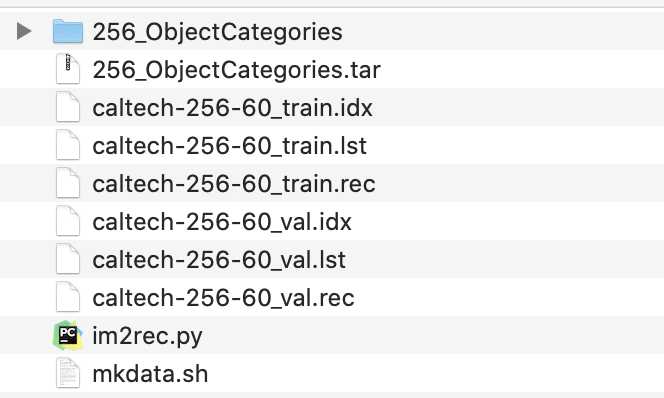标签:mod html 代码 ram val 分数 tca ams read
Gluon版本微调见这里。基于NDarray,类似于Pytorch动态图。而module版本类似于TF,基于Symbol,用的是静态graph。一般静态图用于快速调试见效果,而静态图效率高,速度快,实际中应更多使用。
本文基于module和symbol。利用imagenet训好的模型来微调caltech-256数据集。首先是制作数据:
训练集每类随机采样60张图,其余作为验证集。将图像resize成256,并打包成rec文件:
wget http://www.vision.caltech.edu/Image_Datasets/Caltech256/256_ObjectCategories.tar # 下载解压 tar -xf 256_ObjectCategories.tar mkdir -p caltech_256_train_60 # 划分数据集,训练集每类60张图 for i in 256_ObjectCategories/*; do c=`basename $i` mkdir -p caltech_256_train_60/$c for j in `ls $i/*.jpg | shuf | head -n 60`; do mv $j caltech_256_train_60/$c/ done done python3 im2rec.py --list --recursive caltech-256-60-train caltech_256_train_60/ python3 im2rec.py --list --recursive caltech-256-60-val 256_ObjectCategories/ python3 im2rec.py --resize 256 --quality 90 --num-thread 16 caltech-256-60-val 256_ObjectCategories/ python3 im2rec.py --resize 256 --quality 90 --num-thread 16 caltech-256-60-train caltech_256_train_60/
这段代码实际上是新建了个文件夹,然后把所有数据剪切出去一个训练集,然后针对两份数据生成lst和rec文件。
当然也可以解压后直接这样生成:
tar -xf 256_ObjectCategories.tar python3 im2rec.py --list --recursive --train-ratio 0.6 caltech-256-60 256_ObjectCategories python3 im2rec.py --resize 256 --quality 90 --num-thread 16 caltech-256-60 256_ObjectCategories
注意在生成的时候可能会发生段错误:

这是因为在我的电脑上执行resize 256的时候报错,当我把线程数--num-thread改为1的时候就可以了。或者可以resize 更小例如128的时候4线程就ok。生成的文件:

不想自己生成,官方也给出了这些文件的下载:
import os, sys if sys.version_info[0] >= 3: from urllib.request import urlretrieve else: from urllib import urlretrieve def download(url): filename = url.split("/")[-1] if not os.path.exists(filename): urlretrieve(url, filename) download(‘http://data.mxnet.io/data/caltech-256/caltech-256-60-train.rec‘) download(‘http://data.mxnet.io/data/caltech-256/caltech-256-60-val.rec‘)
然后可以定义data iter:
import mxnet as mx def get_iterators(batch_size, data_shape=(3, 224, 224)): train = mx.io.ImageRecordIter( path_imgrec = ‘./caltech-256-60-train.rec‘, data_name = ‘data‘, label_name = ‘softmax_label‘, batch_size = batch_size, data_shape = data_shape, shuffle = True, rand_crop = True, rand_mirror = True) val = mx.io.ImageRecordIter( path_imgrec = ‘./caltech-256-60-val.rec‘, data_name = ‘data‘, label_name = ‘softmax_label‘, batch_size = batch_size, data_shape = data_shape, rand_crop = False, rand_mirror = False) return (train, val)
下载预训练的resnet18权重并载入。
def get_model(prefix, epoch): download(prefix+‘-symbol.json‘) download(prefix+‘-%04d.params‘ % (epoch,)) get_model(‘http://data.mxnet.io/models/imagenet/resnet/50-layers/resnet-18‘, 0) sym, arg_params, aux_params = mx.model.load_checkpoint(‘resnet-18‘, 0)

然后可以开始训练:
首先定义一个函数替代最后的一层全连接:
def get_fine_tune_model(symbol, arg_params, num_classes, layer_name=‘flatten0‘): """ symbol: the pretrained network symbol arg_params: the argument parameters of the pretrained model num_classes: the number of classes for the fine-tune datasets layer_name: the layer name before the last fully-connected layer """ all_layers = symbol.get_internals() # 得到所有层 net = all_layers[layer_name+‘_output‘] # 注意这里的操作很反直觉,这句话意思是一直取到名字为layer_name的层 net = mx.symbol.FullyConnected(data=net, num_hidden=num_classes, name=‘fc1‘) # 新建一个分类层 net = mx.symbol.SoftmaxOutput(data=net, name=‘softmax‘) # 输出softmax概率 new_args = dict({k:arg_params[k] for k in arg_params if ‘fc1‘ not in k}) # 除了新的全连接层,载入已有的权重 return (net, new_args) # 返回新的网络symbol结构和参数
symbol是和module搭档的,有了symbol,就可以新建module来喂入数据:
import logging head = ‘%(asctime)-15s %(message)s‘ logging.basicConfig(level=logging.DEBUG, format=head) def fit(symbol, arg_params, aux_params, train, val, batch_size, num_gpus): devs = [mx.gpu(i) for i in range(num_gpus)] mod = mx.mod.Module(symbol=symbol, context=devs) # 新建一个module mod.fit(train, val, # train和val的 data iter num_epoch=8, arg_params=arg_params, aux_params=aux_params, allow_missing=True, batch_end_callback = mx.callback.Speedometer(batch_size, 10), # 每10个批量后打印一次训练速度和评价指标metric的值 kvstore=‘device‘, optimizer=‘sgd‘, optimizer_params={‘learning_rate‘:0.01}, initializer=mx.init.Xavier(rnd_type=‘gaussian‘, factor_type="in", magnitude=2), eval_metric=‘acc‘) metric = mx.metric.Accuracy() return mod.score(val, metric)
跑起来:
num_classes = 256 batch_per_gpu = 16 num_gpus = 8 (new_sym, new_args) = get_fine_tune_model(sym, arg_params, num_classes) # 得到新的symbol和参数 batch_size = batch_per_gpu * num_gpus # 计算总的批量 (train, val) = get_iterators(batch_size) # 根据批量得到data iter mod_score = fit(new_sym, new_args, aux_params, train, val, batch_size, num_gpus) # 训练 assert mod_score > 0.77, "Low training accuracy."
Fine-tune with Pretrained Models
标签:mod html 代码 ram val 分数 tca ams read
原文地址:https://www.cnblogs.com/king-lps/p/13060039.html